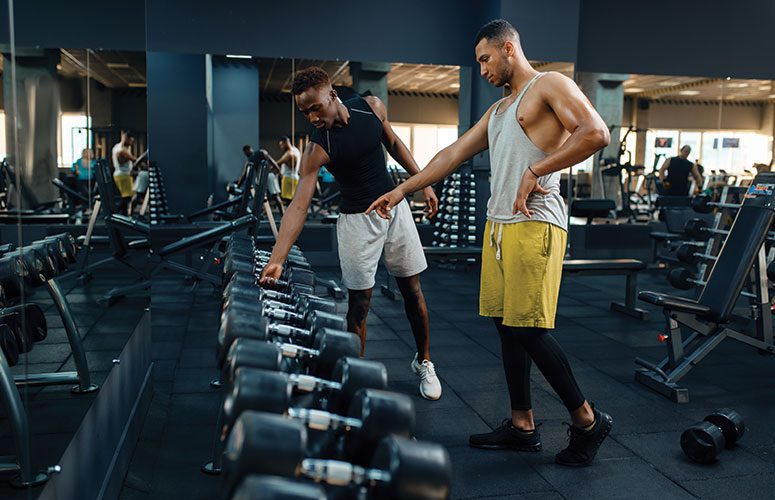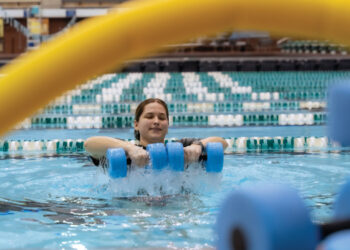Four years prior to the University of Connecticut (UConn) building its new rec center, the team started researching cardio and strength equipment.
It was a big undertaking. Michael D’Alfonso, the associate director of programming, said they visited many campus rec centers around the country and tested anything they could get their hands on at every NIRSA expo. Along with Melissa Frain, the assistant director of business and outreach initiatives, they developed a five-year plan that would allow for a rotation of purchasing, warranties and trade-out.
One of the most critical components to equipment specifications was to set two levels: minimum — the baseline details for each piece of equipment — and preferred — the next-level performance and technical features. “This set us up to have vendors turn in two choices in most equipment categories, providing a top-of-the-line option or a mid-range option,” said D’Alfonso.
But there’s a lot that comes into play in determining those minimum levels. Tabbitha Ashford, the assistant director of Recreation and Wellness at St. Edward’s University, said while they were deep in the Recreation and Athletic Center’s expansion project, there were several factors that led them to outfit the new space with TRUE Fitness products.
First, they took inventory of what was used heavily, what would be neat to have, what users asked for and any current issues with equipment. “From there, we drafted our own version of an ideal layout of the new space and used that to guide our conversations with vendors,” shared Ashford.
In the end, aesthetics, functionality and the final layout played a large part in choosing what equipment to purchase. But, Ashford said other details like size of the equipment came into play. “For example, TRUE’s version of an elliptical has a rear entry and is more compact in comparison to some vendors,” she explained. “This is important to us as we considered maximizing space in our new fitness center.”
Over at the University of Michigan, the Campus Recreation team is in the process of designing its new $150 million Central Campus Recreation Building. Both Ellen Dixon, the assistant director of Fitness and Wellness, and Gerald Ashley, the senior assistant director of the Central Campus facility, have been paying close attention to industry trends and user preference as they are working to choose cardio and strength equipment.
But something else they pay attention to is their maintenance department’s expertise. “[Bring in] the people who are actually working on the treadmills and [ask] what are common issues we are seeing with those, or what brands are really holding true and sticking up to the test of time,” said Dixon. “With the user preference, that’s why we never go with a sole-sourced brand. We always want a little bit of variety from cardio to cardio.”
For that reason, Dixon said they partner well with Matrix Fitness, Life Fitness and Precor. All three companies have been responsive with feedback and allow for equipment testing.
UConn has also used a wide variety of vendors: New England Fitness, Life Fitness/Hammer Strength, Matrix Fitness and Woodway. Frain noted they chose equipment based on layout options, timeline, track record and references, quality, aesthetics of equipment to match the project, and more.
In fact, vendor relationships are essential to Ashford at St. Edward’s. She explained customer service was definitely a key component in picking who to partner with. “It was important to us to partner with someone who not only took care of us in the bidding process — quick response to questions and changes, flexibility on creating our layout, etc. — but who we could trust to be there as we installed the equipment and then opened the building,” she said.
On top of gaining maintenance’s opinion on equipment, Dixon said to also connect with your IT department to ensure consoles on cardio equipment will work correctly in your facility. And, if you’re building a new facility, it’s key to look out ahead when it comes to technology. Ashley explained in their latest round of questions with vendors, they asked if all machines are moving toward a 120 dedicated circuit as they are trying to make decisions for something that will be installed three years down the road.
But with that, choosing equipment means also being flexible and working closely with vendors. Ashley recommended providing them with as much information as possible so they can have a visual of what you’re striving for. “Communication is key,” he said. “It’s not one individual project. It’s everyone working together.”
Cardio and strength equipment choices need to be made with careful consideration and planning. So, although it’s not easy, if done right it can create an experience your students will cherish. And that is the ultimate goal in choosing equipment. “Take your time where possible, consider your user groups and the nature/size of your space, and have fun with the process,” said Ashford.











